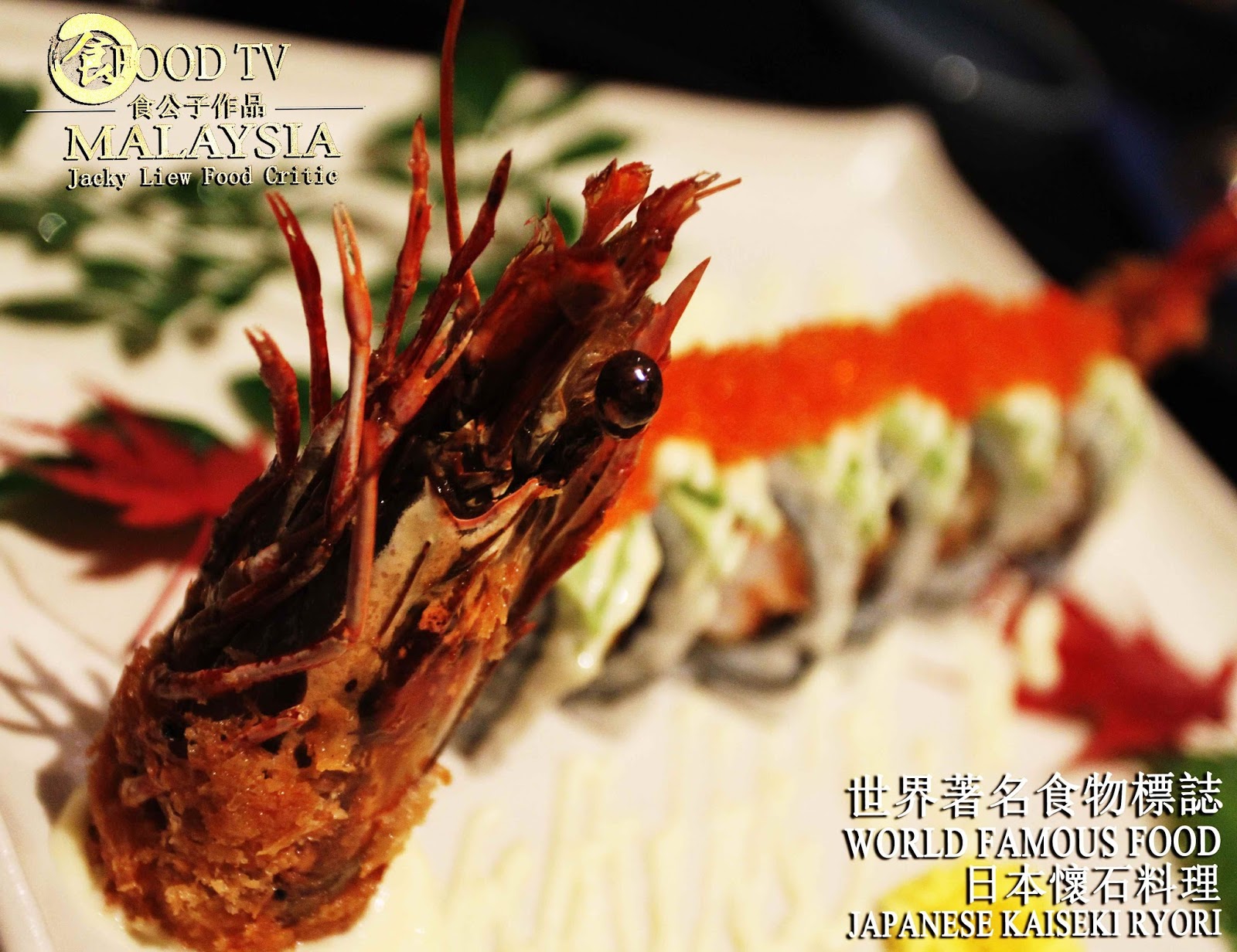FUKUYA福家 日本怀石料理
世界著名食物標誌 World Famous Food@ 福家Fukuya 日本怀石料理 Japanese Kaiseki-ryori
日本怀石料理
Japanese kaiseki-ryōri
在日本传统菜色,寿司、天妇罗早为人熟悉,其中料理怀石Kaiseki,早期称”会席”地位最崇高,一如红楼宴,又因延续禅宗思想,故又有净心料理美谓。主要以三菜一汤作基础。原为寺庙僧侣坐禅时,把石头怀抱以抵制饥饿行为,才有怀石之名。在那年代,非常人消费得起,就是贵。
Tempura, Sushi are very well-known traditional dishes in
Japan, another one of the highlights in Japan traditional cuisine is “Kaiseki” (multi-course
dinner). The first, where kaiseki is written as “会席“ and has a high status in
Japan, just like The Red Mansion Banquet. Kaiseki is a simple meals basically
formed by three dishes and one soup and served on an individual tray. The idea
came from the practice where Zen monks would ward off hunger by putting warm
stones into the front folds of the robes, near their bellies. In those day, kaiseki
is often very expensive and not everyone can afford the prices.
演变至今,已达追求善美之境、讲究季节性新鲜食材及原味极致。后来,再加入日本茶道礼仪“间歇”,不管从器皿、摆盘、庭院到艺伎表演,一套正餐,人客必须宁神静气在等待中。仍未忘饿中听禅的初衷,方是最正宗怀石精神。换句话,就是空着肚子在等上桌,还得以份量美不胜收不忍破坏、控制食欲,最重要还是在吃不饱情况附文风雅,长时间下来,岂能不美味?道理是从折磨人中学习到饮食教养,好高尚的残忍。
All of these cuisines were formalized and developed over
time. In the present day, kaiseki is a type of art form that balances the
taste, texture, appearance and colors of food. Only fresh seasonal ingredients
are used and prepared in ways that aim to enhance their flavor. After that, the
host of a chanoyu gathering serves to the guests before a ceremonial tea and is
also known as “cha-kaiseki”. Guests have to wait patiently in the whole
ceremony including put dish, performance of geisha until meals. This is the spirit
of authentic kaiseki from the monk prolonged and intense contemplation in
hungry. Another words, guests have to wait for the meals with an empty belly. Moreover,
kaiseki dishes often small and artistically arranged, they also have to control
appetite. The important thing is you
have to arty with a hungry stomach, after a long period of time, kaiseki taste
delicious. This is to teach the guests be well-mannered when dining.
其实要尝怀石,得在源起的京都大阪,寻找出风景优美的环境吃,使称上地道。要求也得出自名家,这是原则。位处JALAN
TUN RAZAK,RHB
BANK总行对面JALAN
DELIMA 的FUKUYA福家,那位日本籍主人TAKAO
ANDO和餐厅,绝对有我口述资格。
In fact, kaiseki origin from Kyoto Osaka, to dine kaiseki
must looking for scenic environment. Fukuya restaurants located in Jalan Delima,
opposite to RHB Bank in Jalan Tun Razak. The Japanese boss name’s is Takao Ando.
顺序从先附SAKIZUKE前小菜点起。用宛如流星的鲜海胆配轻盈的酱青与芥末,质感若凉冻蛋黄。听闻这东西,有美人鱼拿来当暗器使。呐,我可没乱写,是听周星驰告诉我的。
Kaiseki usually begin with Sakizuke (bite-sized appetizer), a
sea chestnut just like meteor hammer match with light soy sauce and wasabi. The
texture as cool as yolk. I heard mermaid used it as a hidden weapon, Na, I am
not simply say it, I heard it from Stephen Chow.
另一样北海道帆立贝烧烤鸭肝,亦不输法国鹅肝,你说这心肝宝贝,原本是住在鸡、鸭、鹅体内,现在就这样拿出来BBQ,那感觉是不是有点那个....可怜这些小东西,从此没肝没肺。
Hokkaido fan shell with duck liver, this delicacy rivals
French duck liver, exquisite.
接着是八寸HASSUN,以季节性当造做菜,通常是几份寿司。鲔鱼、红鲷鱼、牡丹虾、琥珀鱼刺身组成,颇有无色香意味形态,就是那种死了,也要让你知道它还活著的美丽。
Hassun ( second course bite-sized appetizer): which sets the
seasonal theme. Typically few kind of sushi. It’s made up with tuna, red
snapper, Botan Shrimp, Amber fish sushi.
至于附加向付MOKUZUKE,关键在选材取上好生鱼片,拿出来晒命,身为日本海的鱼,基因里怎会贪生怕死,早准备为大日本光荣,“新鲜”捐躯。
Mukōzuke: a selection of thinly sliced dish of seasonal raw
fish which is sashimi.
TAKIAWASE,碗盛带汤汁,内里有鲔鱼肚、日本韭菜、豆腐、菇类。最令人着迷处是汤面浮着层鱼脂,极润滑,和止椀TOME-WAN差不多。忽然间,有股想唱Sakura,跳起迎宾舞的冲动。
Takiawase: the soup course, the ingredients are tuna,
Japanese fragrant-flowered garlic, tofu, mushrooms. The surface of soup float
with a layer of fish fat, smooth. Similar to Tome-wan ( a miso-based vegetables
soup).
盖物FUTAMONO,有盖食器的食物。可汤可做茶碗蒸,相似加料的蒸水蛋,有炖萝卜、扇贝、鲜虾、菌类同蛋液炊出,再铺鱼翅酱,大和民族就是大和民族,连蒸粒蛋都讲包装,玩花样。
Futamono: a “lidded dish”. Typically a soup or chawan (egg
custard). Inside it are stewed carrot, fan shell, fresh prawn, mushrooms, egg
and shark fins sauce.
烧物YAKIMONO就是烧鲅鱼,像煎三文,饰以盛紫菜的柿果、日本百合、虾卵等,摆得如诗如画。人道日本最高级料理,是用眼睛吃的,但我怎样学也学不会,还是得靠嘴巴尝,Oishi。
Yakimono: flame-grilled fish, taste like grill salmon. Decorate
with persimmon filled with sea weed, Japanese lily, shrimp egg etc. As
beautiful as a picture. Someone said: The Japanese highest level of cooking
have to taste with eyes, but I’m too clumsy, I only know how to taste with
mouth. Oishi!
强肴SHII-ZAKANA主菜,即是烧烤七成熟和牛,嫩到跟肉脂肪刚热解几乎同感,但又不腻,一口咬定,准错不了。
Shiizakana: a substantial dish, is barbeque wagyu until
medium well, tender and not oily.
御饭GOHAN,配饭菜。以鳄梨寿司配裹上面包屑炸的老虎虾,饭糯、果香甜,有机会、再见。
Gohan: a rice dish made with seasonal ingredients. Avocado
sushi with fried tiger prawn, rice with fruit fragrance. I wish to see this
again.
最后是日本进口,好比浸了三天三夜糖水的蜜瓜,甜到漏。
Last, Mizumono : Japanese import honeydew melon, as sweet as
sweet water. Too sweet.
Phoebe Ooi which served us is praiseworthy, thank you very
much.
立法议员郑立慷和大马美食家食公子,在用完汤饭后,日本籍主人TAKAO
ANDO建议我们尝杯清酒SAKE清清嘴巴,便可进茶席闲话家常,总结一句话,太漂亮了,看过“怀石”的人,会记住一辈子。
After YB Chah Lih Kang and Food Critic Malaysia Jacky Liew finish
the food, Japanese boss Takao Ando suggest use try a cup of sake. Anyone who
has been saw Kaiseki would never forget in the whole life.
FUKUYA 福家
地址:9,
JALAN DELIMA, 55100 KUALA LUMPUR, MALAYSIA
GPS:(101.720214, 3.145076)




































